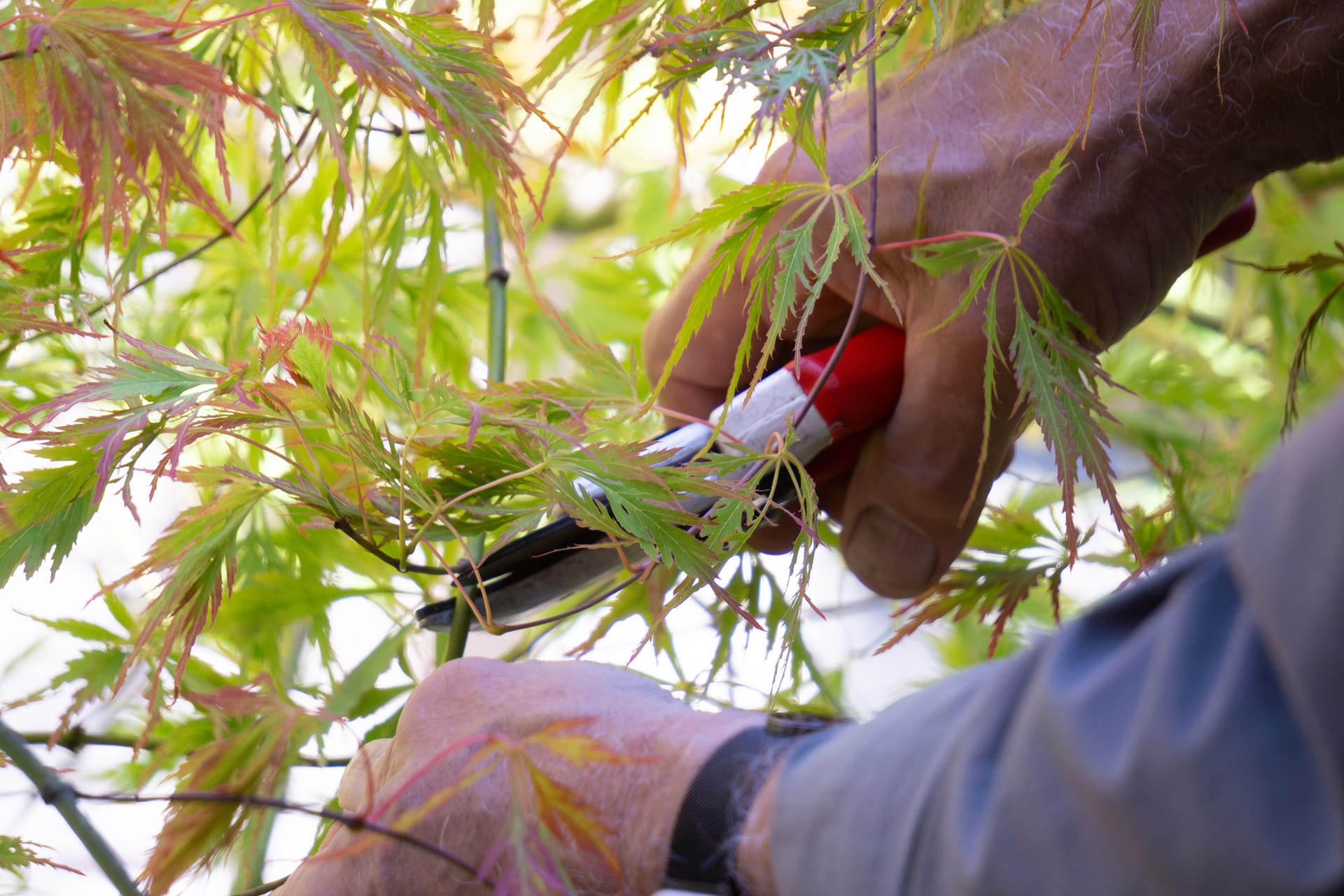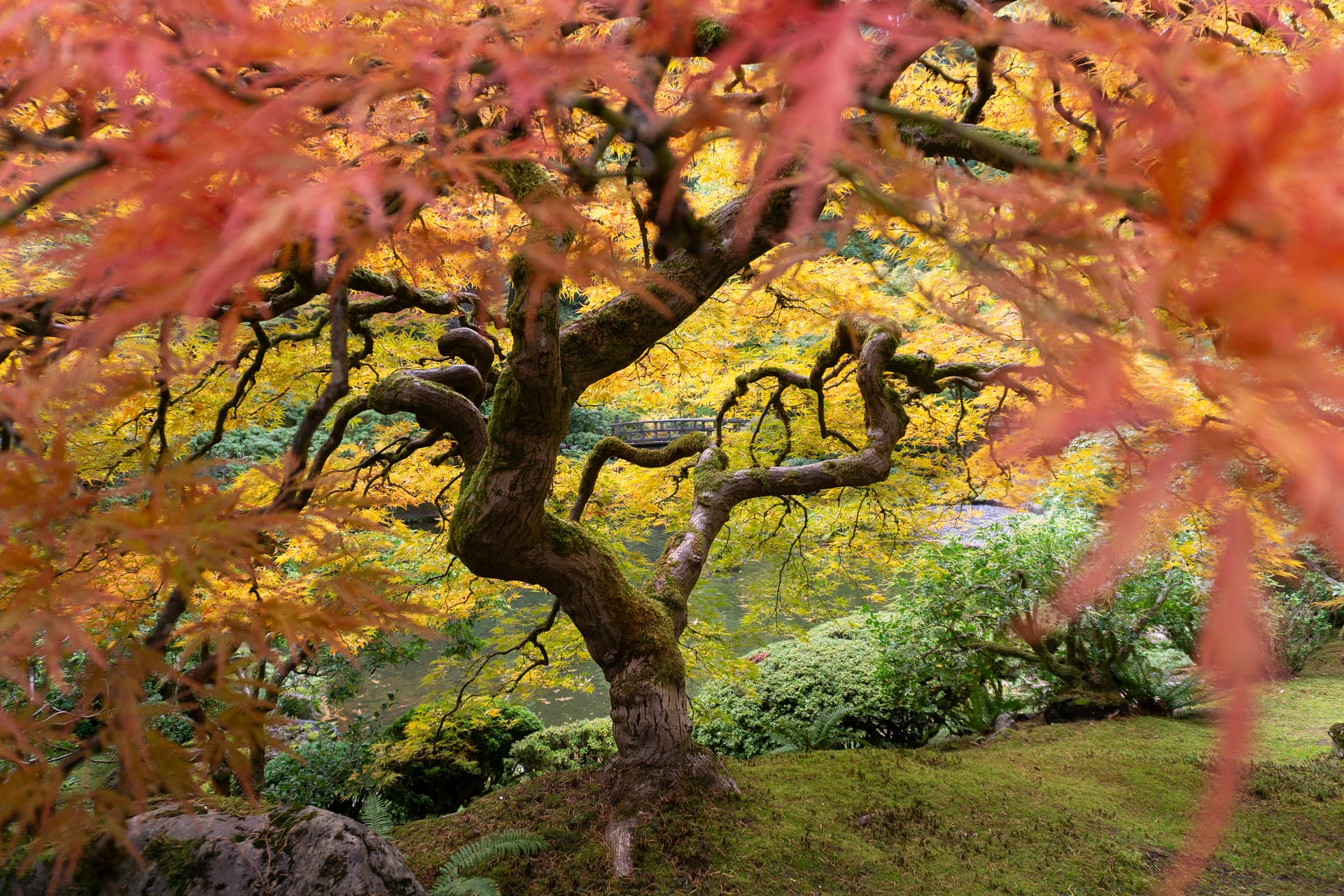
A Peek into a Lifelong, Multigenerational Effort
A maple tree in a space like Portland Japanese Garden can appear like a map of a river and its tributaries, with limbs extending out in a manner simultaneously gnarled and elegant. Stunning in all seasons, Japanese maples seem as though they were placed by divine intervention. It is no wonder that some in Japan consider visiting them a form of communion with nature. In autumn, when these trees transform into stunning displays of crimson, gold, and tangerine, people in Japan will venture out to mountains and wildland to engage in momiji-gari (maple tree viewing).
Maples in the wild are beautiful in their own way, but in Japanese gardens they are shaped into idealized forms, something that is the result of 整姿 (seishi), or the grooming and organization of the branches. With careful consideration of each tree’s location and how it contributes to a space’s composition, gardeners transform it into a more idealized form, while considering its natural form and character through sentei (the pruning of branches). While the best way to learn is through our Maple Pruning Workshops, a coveted member-only program, we hope that this peek into a few basics can help spark an interest in this fascinating horticultural activity.
Be in Harmony with the Seasons

Upright Japanese maples should not be pruned while they are still small. In the first year of pruning look to remove dead wood and branches that rub together—doing so will help bolster the tree’s long-term health. Just keep in mind that you should avoid creating large holes in its canopy. Moving forward, it’s good to be aware of the quieter, often less noticeable innerworkings of your tree as the year progresses and plan accordingly. Just remember—the chart below reflects seasonality in Portland. Consult with local nurseries and horticulturalists on how maples behave in your neck of the woods. Pruning is best thought of as a lifelong and maybe even multigenerational effort. Make sure you consider how decisions today will influence the choices you’ll have to make tomorrow.
| February | The sap will start to flow—if you prune too late, the tree may bleed excessively. |
| March | As spring arrives, leaf buds will begin to emerge. You can prune dead branches during this time. |
| April | Leaves will begin to populate the maple’s branches. |
| May-June | Stems begin to grow and elongate. |
| July-August | Rather than making large cuts, consider only doing some touch-up or minor conditioning. |
| July-September | This is the time to prune branches that are less than 1.5 inches in diameter. |
| November-January | Once the maple has dropped its leaves, the time to make large cuts has arrived. |
Identify Your Pruning “Goal”

“Measure twice, cut once” may be a cliché but that approach is essential when pruning—you can’t take back the cut. Before doing anything, it’s important to determine your goal. Are you cleaning up? Reducing density? Shaping the tree? You also want to remember that no maple exists in a vacuum—take account of the space it’s planted in and how that may influence its growth and shape. Step back regularly and review what you’re doing from a zoomed out perspective. When you begin, start by removing dead, diseased, and broken branches before moving onto the overgrown and crowded ones. Generally speaking, thinning foliage at the top and keeping limbs toward the bottom will help redistribute sunlight and encourage tree growth.
Know Your Tools

There are four tools in particular that are commonly found in the kit of the maple pruner:
- Garden scissors (ki-basami): These are used primarily for detailed work.
- Bypass pruner (sentei-basami): These are good for soft stems that are no more than a 3/4 inch in diameter. Their design allows cutting closer to the trunk of the plant, and thus promotes quicker healing.
- Basic saw (sentei-nokogiri): While these saws can be either straight or curved, most gardeners prefer the straight blade. Save these for medium work that is beyond the capacity of the bypass pruner.
- Pole pruner (takaeda-sentei-basami or takaeda-kiri): These are useful to work on taller trees from the ground. Don’t forget to wear protection for your head and eyes!
Observe Japanese Maples In-Person

It may be tempting to get started after reading an article (like this!) or viewing a video, but the best maple pruning technique comes from observation and in-person education. Next time you visit Portland Japanese Garden, take time to observe the maples and the shapes they take, knowing that everything you see was done carefully and intentionally.
Portland Japanese Garden has three predominant varieties of maples that are present throughout its landscape: upright (Acer palmatum), weeping (Acer palmatum dissectum), and vine (Acer circinatum). While it is only the vine maple that is native to the Pacific Northwest, all three are well-suited to the local Portland climate. However, you may find that one tree fits the space better. The Garden does not simply choose trees based on aesthetics—the shape of the land and potential impacts on labor also play a part. You may find that in tighter spaces a weeping maple will not fit due to its tendency wanting to grow out horizontally. If the space is tight but is open vertically, an upright maple may fit better and so on.
We also recommend becoming a member, so you can enter the lottery for these special programs. Access to these workshops is complemented by a host of worthwhile benefits enjoyed by our members, including exclusive hours to the Garden, early access to many ticketed events, and discounts at the Gift Shop. Interested? Click the button below to become a member today!